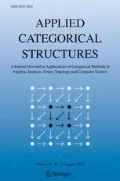Abstract
A general description of the Galois group of a “pointed” normal extension in categorical Galois theory is examined under the presence of a suitable commutator operation. In particular, using the Hopf formula for the second homology group of a group, the connection between Galois theory and group homology is clarified.
Similar content being viewed by others
References
Barr, M., Diaconescu, R.: On locally simply connected toposes and their fundamental groups. Cahiers Topologie Géom. Différentielle Catég. 22–3, 301–314 (1980)
Borceux, F., Janelidze, G.: Galois Theories. Cambridge Studies in Advanced Mathematics 72, Cambridge University Press (2001)
Bourn, D.: Mal’cev categories and fibration of pointed objects. Appl. Categ. Structures 4, 307–327 (1996)
Brown, R., Ellis, G.J.: Hopf formulae for the higher homology of a group. Bull. London Math. Soc 20, 124–128 (1988)
Bunge, M.: Galois groupoids and covering morphisms in topos theory. Fields Inst. Commun. 43, 131–161 (2004)
Donadze, G., Inassaridze, N., Porter, T.: n-Fold C̆ech derived functors and generalized Hopf formulas. K-Theory 35(3–4), 341–373 (2005)
Eilenberg, S., Mac Lane, S.: Relation between homology and homotopy groups. Proc. Natl. Acad. Sci. 29(5), 155–158 (1943)
Everaert, T.: Relative commutator theory in varieties of omega-groups. J. Pure Appl. Algebra 210(1), 1–10 (2007)
Everaert, T., Gran, M., Van der Linden, T.: Higher Hopf formulae for homology via Galois theory. (arXiv:math.AT/0701815 29.01.2007)
Freeze, R., McKenzie, R.: Commutator Theory for Congruence Modular Varieties. London Mathematical Society Lecture Note Series, vol. 125. Cambridge University Press (1987)
Gran, M.: Applications of categorical Galois theory in universal algebra. Fields Inst. Commun. 43, 243–280 (2004)
Gran, M., Rossi, V.: Galois theory and double central extensions. Homology, Homotopy and Applications 6(1), 283–298 (2004)
Gumm, H.P.: Geometrical methods in congruence modular algebra. Mem. Amer. Math. Soc. 45, 286 (1983)
Hagemann, J., Hermann, C.: A concrete ideal multiplication for algebraic systems and its relationship to congruence distributivity. Arch. Math. 32, 234–245 (1979)
Janelidze, G.: The fundamental theorem of Galois theory. Math. USSR Sbornik 64(2), 359–384 (1989)
Janelidze, G.: Pure Galois theory in categories. J. Algebra 132, 270–286 (1990)
Janelidze, G.: What is a double central extension? (the question was asked by Ronald Brown). Cahiers Topologie Géom. Différentielle Catég. XXXII-3, 191–202 (1991)
Janelidze, G.: Precategories and Galois theory. Lecture Notes in Math. 1488, 157–173 (1991)
Janelidze, G.: A note on Barr-Diaconescu covering theory. Contemp. Math. 131(3), 121–124 (1992)
Janelidze, G.: Higher dimensional central extensions and the Brown–Ellis–Hopf formula. International Meeting in Category Theory, Halifax, Canada (1995)
Janelidze, G., Kelly, G.M.: Galois theory and a general notion of a central extension. J. Pure Appl. Algebra 97, 135–161 (1994)
Janelidze, G., Kelly, G.M.: The reflectiveness of covering morphisms in algebra and geometry. Theory Appl. Categ. 3, 132–159 (1997)
Janelidze, G., Kelly, G.M.: Central extensions in universal algebra: a unification of three notions. Algebra Universalis 44, 123–128 (2000)
Janelidze, G., Kelly, G.M.: Central extensions in Mal’tsev varieties. Theory Appl. Categ. 7(10), 219–226 (2000)
Janelidze, G., Marki, L., Tholen, W.: Semi-abelian categories. J. Pure Appl. Algebra 168, 367–386 (2002)
Janelidze, G., Pedicchio, M.C.: Pseudogroupoids and commutators. Theory Appl. Categ. 8(15), 408–456 (2001)
Janelidze, Z.: Subtractive categories. Appl. Categ. Structures 13(4), 343–350 (2005)
Rossi, V.: Galois structures and coverings in universal and topological algebra. Ph.D. Thesis, Udine University (2005)
Smith, J.D.H.: Mal’tsev varieties. Lecture Notes in Mathematics, vol. 554. Springer (1976)
Ursini, A.: On subtractive varieties. I. Algebra Universalis 31, 204–222 (1994)
Author information
Authors and Affiliations
Corresponding author
Additional information
Partially supported by South African NRF.
Rights and permissions
About this article
Cite this article
Janelidze, G. Galois Groups, Abstract Commutators, and Hopf Formula. Appl Categor Struct 16, 653–668 (2008). https://doi.org/10.1007/s10485-007-9107-2
Received:
Accepted:
Published:
Issue Date:
DOI: https://doi.org/10.1007/s10485-007-9107-2


